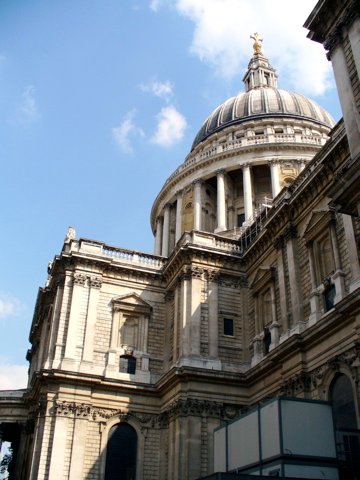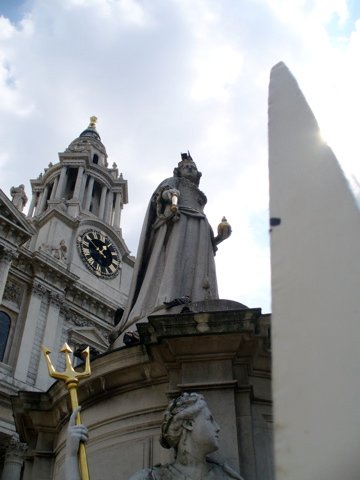
One week after Westminster Abbey, I visited the other great London church, St Paul’s Cathedral. They are very different in form and function. (They are alike in not allowing photography inside, so again I’ve only got exterior shots. I took some more on an earlier excursion.) Westminster Abbey is medieval and gothic. St Paul’s is Renaissance and baroque, one of Christopher Wren’s great churches, rebuilt after the Great Fire of London.

One thing I wasn’t prepared for was how martial St Paul’s is. Although Westminster Abbey has its fair share of soldiers and empire builders buried or memorialised there, most of the names are clergy, doctors, poets and other worthies of their day — and of course kings and queens. At St Paul’s, the overwhelming impression is that of a church for warriors.

Most notable, of course, are the tombs of Wellington and Nelson. The latter in particular dominates the crypt. But also buried here are Admirals Collingwood, Beatty, and Jellicoe, and Field Marshals Roberts, and Wolseley. There are memorials to Pound, Slim, Kitchener and T. E. Lawrence.

It’s not all war of course: this is the statue of Anne,1 out the front of the Cathedral. She looks decidedly imperious (even with a pigeon on her head). It’s a Victorian statue, which may be why at first glance I thought it looked rather Victoriaish.

And the architecture is superb: baroque it may be, but by comparison to the cluttered and jumbled old Abbey, it’s so airy and ordered. I did of course ascend to the Whispering Gallery inside the dome (though the full effect is somewhat lacking when you’re visiting by yourself!), and then up to the Stone Gallery, which is outside the dome, and then right up to the top, to the Golden Gallery which can be seen here. About which, more later. (And my apologies to Sir Christopher for making it look like his creation is about to topple over!)

The views from the Stone Gallery, which runs around the lower edge of the dome, are of course spectacular. This one is looking across the Millennium Bridge to the Tate.

And near the Tate is the Globe Theatre, which I never got around to booking tickets to. Maybe next time (assuming it’s not swept away in the meantime, of course).

The clock tower at the centre is St Pancras, which was one of several railway stations near where I was staying. Judging from the map, my digs were practically along this line of sight from St Paul’s to St Pancras, but would be hidden behind the building with all the satellite dishes. Oh, and the dome on the left is the Old Bailey — the woman with the sword and the scales is probably a bit of a give-away here. But since the building is only a hundred years old, shouldn’t it be the New Bailey? Or, at least, the New Old Bailey?

Hey, it’s an airship! Well, just barely: it looks like it’s one of those hot-air airships (possibly this one). OK, yes, it’s lighter-than-air and it moves under its own power, but it’s not quite the same, is it. I’ll never complain about the Holden airship again!

Paternoster Square, from above.

This is the Thames (looking towards Waterloo Bridge) from the Golden Gallery, 434 steps up from the floor of the Cathedral. Not a great picture, mainly it’s just to prove that I did in fact make it up to the top!

To end back on terra firma again, this is Temple Bar, which now guards the passage between St Paul’s and Paternoster Square. Formerly it was at the point where the Strand turns into Fleet Street; in 1878 it was pulled down so the road could be widened, and in 1880 was bought by a beer baron for his house in Hertfordshire. Not until 2004 did it come back to London, though not of course to its original location. It’s another Wren post-1666 design, which, charmingly, was used to display the heads of traitors (on spikes, naturally) until the mid-18th century, the last two being the Jacobite officers Francis Towneley and George Fletcher, who were captured when Carlisle fell in 1745. And there they remained until 1772!
![]() This work is licensed under a Creative Commons Attribution-NonCommercial-NoDerivatives 4.0 International License.
Permissions beyond the scope of this license may be available at http://airminded.org/copyright/.
This work is licensed under a Creative Commons Attribution-NonCommercial-NoDerivatives 4.0 International License.
Permissions beyond the scope of this license may be available at http://airminded.org/copyright/.
- Not to be confused with the Statute of Anne. [↩]

Pingback: Airminded · Paternosters